Guidelines: How To Write About People with Disabilities (9th edition)
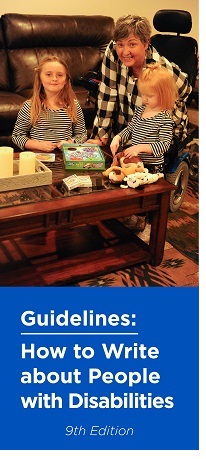 Contents
Contents
- Portrayal Issues
- Key Concepts in the Disability Community
- Acceptable Language Options
- Rosa's Law and the Language of Bullying
- Thanks to Our Reviewers
Guidelines: How To Write About People with Disabilities (PDF)
Introduction
Your Words, Our Image
How do you know the correct word to use for a report, blog post, tweet, or video?
If you are a reporter or other type of professional communicator, you consult your profession's style guide. That's why the first edition of the Guidelines, published in 1984, was modeled after the Associated Press (AP) Stylebook. We wanted to reach reporters and editors, whose word choice influences their audience's attitudes toward people with disabilities.
Responses were positive. In the following years, The Associated Press Stylebook, the Publication Manual of the American Psychological Association (6th Edition), the American Association for the Advancement of Science, and other professional organizations adopted recommendations from the Guidelines, beginning with the recommendation to avoid the term handicapped in favor of disabled.
More than 30 years later, thanks to the internet and social media, people have a multitude of options for public self expression. Today we offer this resource to all communicators who seek guidance on objective, respectful disability terminology.
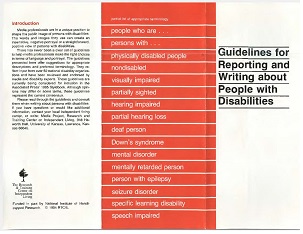 The first edition of the guidelines was published in 1984. Since then, more than one million copies have been distributed
The first edition of the guidelines was published in 1984. Since then, more than one million copies have been distributed
Who Says?
The recommendations in the Guidelines are based on a survey of national disability organizations and individuals with disabilities. We cannot represent every opinion, but we do acknowledge that among people with disabilities, there are two main preferences: "person-first" and "identity-first" or "identity" language. We include terms to satisfy both options, and just as importantly, list terms that should never be used.
Because language evolves, we will update this online version of the Guidelines. Please let us know what you think on social media. You can help us keep our recommendations current.
The first edition of the Guidelines was produced with funding from the National Institute on Disability and Rehabilitation Research, now the National Institute on Disability, Independent Living, and Rehabiliitation research (NIDILRR). Since then, more than one million copies have been distributed, the online version is used by people around the world.
Choosing Words of Respect
When the U.S. disability rights movement began in the 1970s, advocates wanted to change the laws, practices, and attitudes that affected people with disabilities. Person-first language--which literally puts the person first in the sentence--offered a way to acknowledge that a person's disability is only one aspect of their identity.
Person-first language is used in the title of the 1990 landmark civil rights law, the Americans with Disabilities Act (ADA).
Person-first language acknowledges a person's humanity before conveying an objective fact. She uses a wheelchair is a person-first alternative to the inaccurate, outdated, and offensive wheelchair-bound.
Of course, language and the people who use it change. Some have begun to consider person-first language a patronizing and euphemistic maneuver that avoids confronting the reality of disability on its own terms. Many in the disability community now prefer identity language (also known as identity first), which expresses disability pride with direct statements such as I am deaf [or] autistic [or] disabled. Identity language focuses on I am rather than I have to proudly acknowledge one's disability.
Communicators can become confused about which of the two options to choose. Ask the person you are writing or speaking about which approach they prefer. If you adopt respect for the individual as your guiding principle, you can have an open conversation that acknowledges both the disability and the unique identity and shared humanity of all. How do you describe yourself? or How should I describe your disability? are simple ways to begin.
If the decision is left to you, either is fine, and most people will honor a genuine attempt to be respectful. A study of the two approaches, published in American Psychologist, found that there is too much diversity of opinion to recommend one over the other: "Although a definitive mandate for writing and speaking about disability might be desirably, we suggest that flexibility is an appropriate, respectful response."
Portrayal Issues (What is "Normal"?)
About one in five Americans has a disability, which the Americans with Disabilities Act (ADA) defines as a physical or mental impairment that substantially limits one or more major life activities. This law defines disability in terms of difficulty performing a function that most people consider routine, such as bathing, eating, providing one's own transporation, or managing one's own finances.
People with disabilities, like all people, have strengths and weaknesses, successes and failures, and hopes and dreams.
People with disabilities are the largest minority group in America, and the only group that any person can join at any time--through disease, traumatic event, or other reason. Like other minority groups, there is much diversity within the disability community, and people with disabilities don't want to be stereotyped when their stories are told.
Historically, the media has treated people with disabilities as "objects of pity, charity, or medical treatment that have to overcome a tragic and disabling condition, or conversely, presented [them] as superheroes who have accomplished great feats, so as to insipre the non-disabled" (United Nations). The late 2010s saw progress in "authentic representation" of people with disabilities in the media, with a study by the Ruderman Foundation finding an increase between 2016 and 2018 from 5% to 12% of characters with disabilities being played by an actor with the same disability.
By following these guidelines, you can contribute to this momentum, portraying people with disabilities in an objective, authentic way.
Put Away the Pity.
Saying victim of, afflicted with, or suffers from portrays individuals with disabilities as passive objects of pity and charity. State the facts in neutral terms, saying person who has MS.
Emphasize Abilities, not Limitations.
For example, uses a wheelchair rather than confined to a wheelchair. Wheelchairs and other assistive devices enable their users to be more independent; wheelchair user emphasizes a person's mobility, but confined to a wheelchair is an explicit reference to limitations on a person's mobility.
Find Inspiration Elsewhere.
Do not portray successful people with disabilities as heroic overachievers or long-suffering saints. Every human faces challenges in life. Even though the public may find such portrayals inspirational, these stereotypes raise false expectations for people with disabilities. To describe these stereotypes, advocate Stella Young coined the term "inspiration porn" in her 2014 ted Talk, I'm Not Your Inspiration, Thank You Very Much (YouTube).
Do not Condescend or Use Euphemisms.
Terms such as special, challenged and handicapable reinforce the idea that people cannot deal honestly with their disabilities. While special is used in the names of educational programs and organizations, many people with disabilities, who want to be treated like everyone else in their community, consider the use of special needs offensive. Special also implies a need to be taken care of, which is frequently not true. Just say children with disabilities.
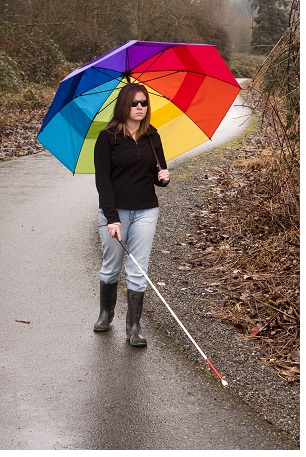 Do not Equate Disability with Illness.
Do not Equate Disability with Illness.
Although some people with disabilities also have chronic illnesses, and some people have disabilities due to chronic illness, people with disabilities CAN be healthy. A disability is not a disease. Do not imply disease if a person's disability resulted from anatomical or physiological difference (for example, a person with spina bifida). Do not refer to people with disabilities as patients unless their relationship with their doctor is under discussion or they are referenced in the context of a clinical setting.
Respect the Person.
Do not use offensive words such as retard, freak, lame and vegetable. These are dehumanizing, inaccurate and archaic expressions that only extend negative stereotypes and beliefs about people with disabilities.
Key Concepts in the Disability Community
These terms and concepts may be helpful when writing or speaking about people with disabilities.
Ableism
Refers to discrimination against people with disabilities in favor of people without disabilities. It can be deliberate or unintentional, but it is always based on assumptions that people with disabilities do not matter, have less intrinsic worth, or cannot manage their own lives as well as people without disabilities. Ableism prevents people with disabilities' full inclusion in society. Examples include multistory buildings without elevators or using the term retarded as an insult.
Accessible
Describes environmental conditions that support greater independence of people with disabilities, such as curb ramps at intersections, sign language interpreters at public events, or braille labels on elevator buttons. The term also describes adaptations to products and services to support greater independence of people with disabilities, such as captioning or sign language interpretation. Handicapped has negative connotations because it suggests that obstacles to participation reside in the person rather than in the environment.
Advocacy
Is an active process designed to make institutions and social and political systems more responsive to the civil rights, needs and choices of individuals. Through individual and group advocacy, people with disabilities can communicate their rights under various civil rights laws and participate in decision-making that affects them. Self-advocacy refers to a movement of people advocating for themselves rather than others, such as parents or service providers, advocating on their behalf.
Categories of disability
Are sometimes used to broadly describe a type of disability. Categories of disability include: visible/invisible; physical; mobility; sensory; cognitive; mental illness/psychiatric disability; and acquired/congenital.
Consumer
Is the term used by many, but not all, in the disability community to refer to someone who receives (or consumes) services and supports. The civil rights movement in the U.S. inspired the Independent Living Movement in the 1970s, which maintained that people with disabilities are consumers of assistive services and have a responsibility to evaluate and control the services they use. On a similar note, some people prefer to be described by what they use, such as wheelchair user, ventilator user, or mental health service user. However, others would rather not be defined as consumers but prefer to emphasize their unique identities and contributions to society. Consider the relevance of the assistive supports and services a person uses, and when in doubt, ask.
Disability humor
Can function like other forms of minority humor, creating bonds among people with disabilities. They may "reclaim" or refer to themselves with the same offensive terms that we urge you to avoid, but this type of familiarity should not be adopted by those outside the group. Examples include the word crip in the "Crip the Vote" campaign, which engages voters and politicians in discussion of disability issues, or in the title of the film "Crip Camp" which discusses the history of the disability rights movement.
Independent Living (IL)
Refers to the philosophy that people with disabilities should be able to make decisions that affect their own lives. IL also refers to a civil rights movement that advocates for equal participation in community life, and to a nationwide system of Centers for Independent Living (CILs). These nonresidential resource centers are run by and for people with disabilities and for the benefit of the entire community. CIL core services include advocacy, information and referral, independent living skills training, peer counseling, and transition of people with disabilities from youth to adult services and settings, and from institutions to the community.
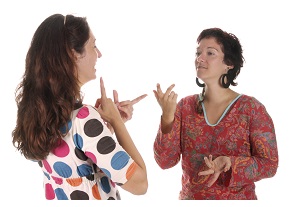
Inclusion
Is the concept that people with disabilities have the same rights and opportunities for education and community living as their nondisabled peers, and that those opportunities are not segregated from the rest of society.
The social model
This model of disability approaches disability differently than the medical model, which regards disability as a defect that must be cured or normalized through medical intervention. The social or Independent Living (IL) model regards disability as a neutral difference between people--and acknowledges that people with disabilities can be healthy. The social model seeks not to change the person with the disability but social attitudes, physical environments, public policies, and other barriers to full participation.
Acceptable Language Options: A Partial Glossary of Disability Terms
We know that language shapes perceptions, so a small word choice can make a big difference in shaping attitudes towards people with disabilities and assumptions about the quality of their lives.
As discussed in the previous pages, there are two main types of disability language: person-first language and identity or identity-first language. Person-first language emphasizes the person, not the disability. Identity language emphasizes the person’s disability, reclaiming terms that were once considered labels to convey pride.
Person-first language: He is a person with a disability.
Identity language: He is a disabled person.
To be as inclusive as possible, we illustrate both person-first, and in some cases, identity words and phrases in these alphabetical entries. Please note that these are guidelines, not rules.
Acquired disability
Refers to a disability (other than a developmental disability) that occurred sometime after birth. Say she acquired her disability in a car crash.
Amputee, limb loss and limb difference
Are terms used to describe a person who has lost a limb due to an accident or illness. Limb difference is more often used for people who have a congenital condition (one that was present at birth). Descriptive terms like lower- or upper-limb loss and below-knee or above-knee amputation may be used, e.g., She has upper-limb loss or Her leg was amputated above the knee.
ADHD (Attention Deficit Hyperactivity Disorder)
Is the clinical diagnosis for a genetic neurobehavioral condition that is characterized by symptoms in three categories: inattention, excessive activity and impulsive behavior. Say person with ADHD. Do not use hyper or lazy.
Autism spectrum disorder (ASD)
Refers to a complex neurodevelopmental disability that may cause differences in social interaction, verbal and nonverbal communication, sensory processing, and repetitive behaviors. People who are not autistic and do not have other cognitive disabilities are sometimes refered to as neurotypical. Asperger’s syndrome, which was previously considered a stand-alone diagnosis, was removed from the Diagnostic and Statistical Manual of Mental Disorders in 2013 and is now considered under the ASD umbrella. People on the autism spectrum can have significant limitations in one area with no limitations in others. Use child with autism, person on the spectrum or autistic man. Labels like high-functioning and low-functioning are not helpful because such distinctions can impact the way an autistic person is treated and are considered offensive by the autistic community.
Blind and Low Vision
Describes a condition in which a person has loss of sight for ordinary life purposes. A person is legally blind when vision with best correction is no better than 20/200. Low vision and vision loss are generic terms for vision loss caused by macular degeneration and other conditions. Low vision usually refers to someone who is legally blind, but can still see large print, bright colors, light and shadow and large shapes, while vision loss refers to those who have lost vision after birth. Say he is blind or girl who has low vision. (You may ask which term best suits the person.) Some blind people consider themselves visual thinkers so they regard visually impaired and visually challenged as negative terms.
Brain injury and traumatic brain injury (TBI)
Describe a condition where there is long-term or temporary disruption in brain function. The two types are distinguished by cause, with a non-traumatic or acquired brain injury resulting from an internal event, like a stroke or seizure, whereas a TBI results from an external injury, such as a from fall or car crash. Difficulties with cognitive (thinking, remembering, learning), physical, emotional and/or social functioning may occur. Use person with a brain injury or person who has a traumatic brain injury. Do not say brain damaged.
Chemical and/or electromagnetic intolerances or sensitivities
Describe chronic medical conditions characterized by neurological impairment, muscle pain and weakness, respiratory problems and gastrointestinal complaints. Reactions for those with chemical intolerances are triggered by low-level exposure to everyday substances and products, including pesticides, solvents, cleaning agents, new carpeting and adhesives, fragrances and scented products.
Electrical hypersensitivities are triggered by electromagnetic fields from electrical devices and frequencies. Chemical and electromagnetic intolerances or sensitivities are also called toxicant-induced loss of tolerance (TILT), environmental illness or sick building syndrome. Use person with chemical intolerance, person with electrical hypersensitivities or people with environmental illness. Do not use the terms chemphobic or idiopathic environmental intolerance.
Chronic health conditions or diseases
Refer to conditions that are persistent, generally lasting more than three months, not preventable by vaccines, and not curable by medication. There is some variation in use of this term. The Centers for Disease Control and Prevention (CDC) classify heart disease, stroke, cancer, diabetes, obesity, and arthritis as examples of chronic diseases. The Centers for Medicare and Medicaid Services have a more extensive list of chronic conditions that includes dementia, depression, and HIV. Use person with cancer or people who have AIDS. Do not use the term victim, e.g., AIDS victim.
Cleft palate or lip
Describes a specific congenital disability involving the roof of the mouth, lip and gum. Say person who has a cleft palate. The term hare lip is anatomically incorrect and stigmatizing.
Congenital disability
Describes a disability that has existed since birth but is not necessarily hereditary, such as cerebral palsy. Use person with a congenital disability or person with a disability since birth. Birth defect and deformity are considered offensive.
Deaf and hearing impairment.
Deaf refers to a degree of hearing loss that is significant enough to prevent understanding speech through the ear. Deaf people usually identify as the Deaf or Deaf community (with a capital D) rather than people who are deaf. Deaf people are part of a specific community made up of those who share a common culture and sign language.
Hearing impairment, hearing loss, deafness, or hearing difficulties are generic terms used by some individuals to indicate any degree of hearing loss, from mild to profound, although some perceive the term hearing impaired as negative. Members of the Deaf community do not use any of these terms as they are medically defined.
Hard of hearing refers to those with a mild to moderate hearing loss who may use technology for amplification. A person who has hearing difficulties may have speech difficulties, too, but deafness does not affect mental abilities. Say deaf woman or hard of hearing boy. People who have some degree of hearing and vision loss prefer the term Deaf-Blind. Never use deaf and dumb or deaf mute.
Developmental disability (DD)
Is an umbrella term for a number of life-long conditions apparent during the developmental period. The developmental period is generally understood to end at the age of 22. The most common DD conditions are intellectual disability, Down syndrome, autism, cerebral palsy, spina bifida, fetal alcohol syndrome, and fragile X syndrome. Although the term intellectual disability is often used in conjunction with developmental disability, many people with a developmental disability do not have an intellectual disability. The acronym “IDD” is used to describe a group that includes people with ID, people with another DD and/or people with both. The supports that people with DD or IDD need to meet their goals vary in intensity from intermittent to pervasive. Say she has cerebral palsy, he has a developmental disability or he is autistic. Do not say mentally retarded.
Disability
Is a general term used to indicate that the environment does not accomodate a person’s abilities. The term may refer to a physical, sensory, or mental condition. Do not use the term handicapped because many people with disabilities consider it offensive.
Some people object to the term disabled because it suggests the person has an inability to function (as in a disabled car) and it suggests that people with disabilities are a homogeneous group. Others proudly claim disabled as part of their identity, and others prefer the terms difference and differently abled because they avoid the negative implications of disability. However, some consider differently abled a euphemism that does not acknowledge the truth.
Again, language is always evolving. The range of available terms reflects a movement toward greater inclusivity, which is a positive development. When in doubt, ask. When you can’t ask, use people with disabilities or the disability community.
Disfigurement
Refers to cosmetic or physical changes to the body caused by burns, trauma, disease, congenital conditions, surgery, or other events. Although disfigurement may not affect a person’s functional abilities, it can limit a person’s opportunities because of fear and bias from others. Do not say burn victim. Say burn survivor or child who has burns.
Down syndrome
Describes a specific chromosomal condition that results in intellectual disability, a distinctive appearance, and particular health concerns. Down syndrome is a developmental disability. Say person with Down syndrome. Do not use mongoloid or Down person.
Intellectual disability (ID)
Is a condition defined by substantial limitations in both intellectual functioning and adaptive behavior that are apparent during the developmental period. ID is a developmental disability, and the supports that people with ID need to meet their goals vary in intensity from intermittent to pervasive. Though mental retardation was once an accepted clinical term, it became commonly used as an insult or slur, so people who have ID, their families, and advocacy organizations campaigned to end its use. Say people with intellectual disabilities. Do not use retarded, mentally retarded or subnormal. (See “Rosa’s Law and the Language of Bullying” for more details.)
Invisible disabilities, sometimes called hidden disabilities
Include a wide range of conditions that are not immediately apparent to others, such as autism spectrum disorders, mental health conditions, learning disabilities, and fibromyalgia. Some people with accessible parking permits have an invisible disability, so it is not fair to assume they are not permitted to use an accessible parking space based on their appearance.
Language disorder
May inhibit a person’s ability to speak, read, write, or understand spoken or written language. A language disorder can be either developmental or acquired. There is debate within the speech-language-hearing community about whether Developmental Language Disorder or Specific Language Impairment is the more appropriate term. Aphasia affects people’s ability to speak, understand spoken language, read, or write. Aphasia can have many different causes, such as a stroke, brain injury, neurological illness, or dementia.
Learning disabilities
Refer to a number of disorders which may affect the acquisition, organization, retention, understanding or use of verbal or nonverbal information. These disorders affect learning in individuals who otherwise demonstrate at least average abilities essential for thinking and/or reasoning. As such, learning disabilities are distinct from global intellectual disability. Learning disabilities result from impairments in one or more processes related to perceiving, thinking, remembering or learning. These include but are not limited to: language processing, phonological processing, visual spatial processing, processing speed, memory and retention, and executive functions, such as planning and decision making. Dyslexia is an example of a learning disability. Say person with a learning disability. Do not use slow learner or retarded.
Little person or person of short stature
Describes people who have a variety of genetic conditions that cause them to grow to less than 4’10” tall. Dwarfism is a medical term, but it should not be used as general terminology. Do not refer to these individuals as midgets because the term carries circus sideshow connotations.
Mental illness and psychiatric disability
Refer to a variety of psychological conditions. Say person with a mental illness or psychiatric disability. If necessary for medical or legal accuracy, use diagnostic terms such as schizophrenia, psychosis, or bipolar disorder (which replaced manic depression). Words such as crazy, maniac, lunatic, schizo and psycho are offensive and should never be applied to people with mental health conditions. For more detail, refer to the Entertainment Industries Council’s online style guide.
Nondisabled
is the preferred term when the context requires a comparison between people with and without disabilities. Use nondisabled or people without disabilities instead of able-bodied, normal or healthy.
Physical disability
Is an umbrella term that refers to conditions affecting a person’s physical functioning, dexterity, and stamina, thereby affecting a person’s ability to operate in their environment. Examples include spinal cord injury, amputation, and other conditions that may have physical manifestations, like multiple sclerosis or stroke.
Post-polio syndrome
Is a condition that affects some people long after their recovery from poliomyelitis (polio). It is characterized by muscle weakness, joint and muscle pain, and fatigue. People who experience post-polio syndrome are not currently experiencing the active phase of the virus. Say person with post-polio syndrome. Do not use polio victim.
Seizure
Describes an involuntary muscle contraction and/or a brief impairment or loss of consciousness resulting from a neurological condition such as epilepsy or a brain injury. Say girl with epilepsy or teen with a seizure disorder. Do not use epileptic fit or spastic attacks.
Sensory disability
Is an umbrella term that refers to conditions of sight, hearing, touch, smell or taste. Blindness and deafness are sensory disabilities. Autistic people may have sensory disabilities or hypersensitivity to sounds, lights, or other sensations. People who have a sensory processing disorder have trouble receiving and responding to information gathered through the senses.
Service animal or service dog
Describe animals that have been individually trained to assist or perform tasks for people with disabilities. In addition to guiding people with blindness or low vision, they may alert deaf people, pull wheelchairs, alert and protect a person who is having a seizure, remind a person to take prescribed medications, or calm a person with post-traumatic stress disorder during an anxiety attack. Seeing eye dog is an outdated and less inclusive term.
An emotional support animal is an assistance animal that may or may not have special training and is recognized as a reasonable accommodation for a person with a disability under the federal Fair Housing Act. While emotional support animals are often used as part of a medical treatment plan as therapy animals, they are not considered service animals under the ADA and may be prohibited in public spaces.
Speech disability
Is an umbrella term for several conditions in which a person has limited speech patterns. Use child who has a speech disability. For a person without speech capability, say non-speaking or person without speech. Do not use mute or dumb.
Spinal cord injury (SCI)
Describes a condition in which there has been permanent damage to the spinal cord, resulting in some degree of impairment or paralysis. Quadriplegia or tetraplegia denote some loss of function in all four extremities, while paraplegia refers to loss of function only in the lower part of the body. In both cases, the individual might have some function in the affected limbs. While people with spinal cord injuries may refer to themselves as a para or a quad, communicators should use man with paraplegia, woman with paralysis or person with a spinal cord injury. Don’t say cripple or handicapped.
Substance use disorder
Refers to patterns of drug or alcohol use that result in significant impairment in at least three life areas (family, employment, health) over any 12-month period. Although such terms as alcoholic and addict are medically acceptable, some individuals may consider them derogatory. More acceptable terms are people who are substance dependent or person who is alcohol dependent. Individuals who have a history of dependence on alcohol and/or drugs and are no longer using alcohol or drugs may identify themselves as recovering or as a person in recovery.
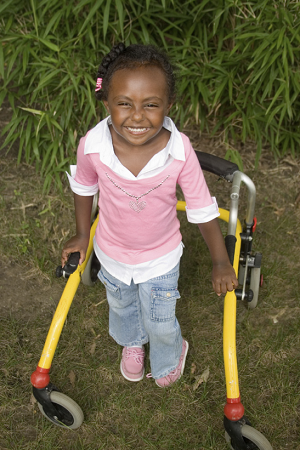
Survivor
Is used to affirm a person’s recovery from an adverse health condition such as cancer, burns, brain injury, or stroke. Use cancer survivor or brain injury survivor. Survivor is preferable to victim because it recognizes a person’s ability to grow, change, and overcome adversity.
Visible disabilities
Are conditions which others can observe. Visible disabilities include many physical disabilities, Down syndrome, and conditions that require the obvious use of supports such as communication devices, external hearing aids, crutches, etc.
Wheelchair user
Refers to a person who uses a wheelchair. People with any number of disabilities may use wheelchairs, and people may use wheelchairs continuously or only under certain conditions. Don’t say wheelchair-bound or confined to a wheelchair, as these terms are inaccurate and convey pity, and a wheelchair or other assistive device enables the user to participate more fully in life.
Rosa's Law and the Language of Bullying
Signed into U.S. law in 2010, Rosa’s Law replaced the term mental retardation with the phrase intellectual disability in federal health, education, and labor statutes; this change has now been reflected in the statutes of every U.S. state. The law was named for nine-year-old Rosa Marcellino, whose brother Nick explained the change in Remarks by the President at the Signing of the 21st Century Communications and Accessibility Act:
“What you call people is how you treat them. If we change the words, maybe it will be the start of a new attitude towards people with disabilities.”
A national campaign called “Spread the Word to End the Word” helped raise the public’s awareness about ending use of the word retarded.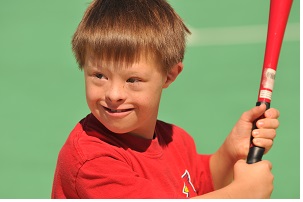 This movement was also part of the battle against bullying, which often begins with demeaning and destructive words.
This movement was also part of the battle against bullying, which often begins with demeaning and destructive words.
Similarly, the Individuals with Disabilities Education Act (IDEA) was known as the Education for All Handicapped Children Act from 1975 to 1990. The U.S. Congress changed the name to convey the dignity of all students.
Thanks to Our Reviewers
We are grateful to many individuals and disability organizations for their input on this edition of the Guidelines. A partial list of contributors includes:
- American Association on Intellectual and Developmental Disabilities
- Association of University Centers on Disabilities
- Autistic Self Advocacy Network
- Beach Center on Disability
- Center for Research on Women with Disabilities at Baylor College of Medicine, Houston, TX
- Christopher and Dana Reeve Foundation
- Great Plains ADA Center
- Learning Disabilities Association of America
- National Alliance on Mental Illness
- The National Association of the Deaf
- National Center for Environmental Health Strategies
- National Council on Independent Living
- National Federation of the Blind
- Tarjan Center at UCLA
- United Spinal Association
Research and Training Center on Independent Living
The University of Kansas
4089 Dole Center, 1000 Sunnyside Ave.
Lawrence, KS 66045-7561
E-mail: rtcil@ku.edu
Phone: 785-864-4095
TTY: 785-864-0706
The contents of this publication were developed under a grant from the National Institute on Disability, Indpendent Living, and Rehabilitation Research (NIDILRR grant number 900RT5043). NIDILRR is a Center within the Administration for Community Living (ACL), Department of Health and Human Services (HHS). These contents do not necessarily represent the policy of NIDILRR, ACL, HHS, and you should not assume endorsement by the Federal Government.